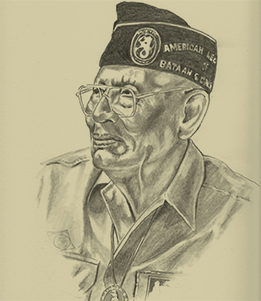

 Awards
Search
Awards
Search

Corporal
Phillip W. Coon
Army
Inducted 2016
Corporal Phillip W. Coon was born 28 May 1919 in Okemah, Oklahoma, and is a graduate of Haskell Institute in Lawrence, Kansas. He is a citizen of the Muscogee Creek Nation. He enlisted in the Army in 1941 and received training as a Heavy Machine Gunner and in Jungle Warfare. Coon was later assigned to the 4th Squad, H Company, 31st Infantry Regiment.
Following the surrender of the Bataan Peninsula on the main Philippine island of Luzon to the Japanese in World War II, Coon was captured on Bataan 11 April 1942 by the Imperial Japanese Army. Known today as the infamous "Bataan Death March," he and approximately 75,000 Filipino and American troops were forced to make the arduous 65-mile march to prisoner of war camps. Thousands died en route from disease, starvation, dehydration, heat prostration, wanton execution, and untreated wounds. Coon was one of approximately 54,000 prisoners who survived the death march.
Crammed into railroad boxcars, Coon was moved every few months to different prison camps during his 3 ½ years as a POW. Coon's final journey as a POW occurred from September 1944 to January 1945 when the Japanese Imperial Army and Navy moved prisoners from the Philippine Islands to Japan via "Hell Ships." Crammed into cargo holds, many died due to asphyxia, starvation, dysentery, and extreme heat and humidity. Subjected to harsh slave labor conditions at a copper mine labor camp, Coon was liberated following the Japanese surrender in September 1945. He was discharged in 1946.
Cpl Coon's decorations and awards include the American Defense Service Ribbon with one Bronze Star, the Asiatic Pacific Campaign Ribbon with two Bronze Stars, the Philippine Defense Ribbon with one Bronze Star, and the Distinguished Unit Award with two Oak Leaf Clusters. He also received the Cross of Valor from the Oklahoma Veterans Commission.